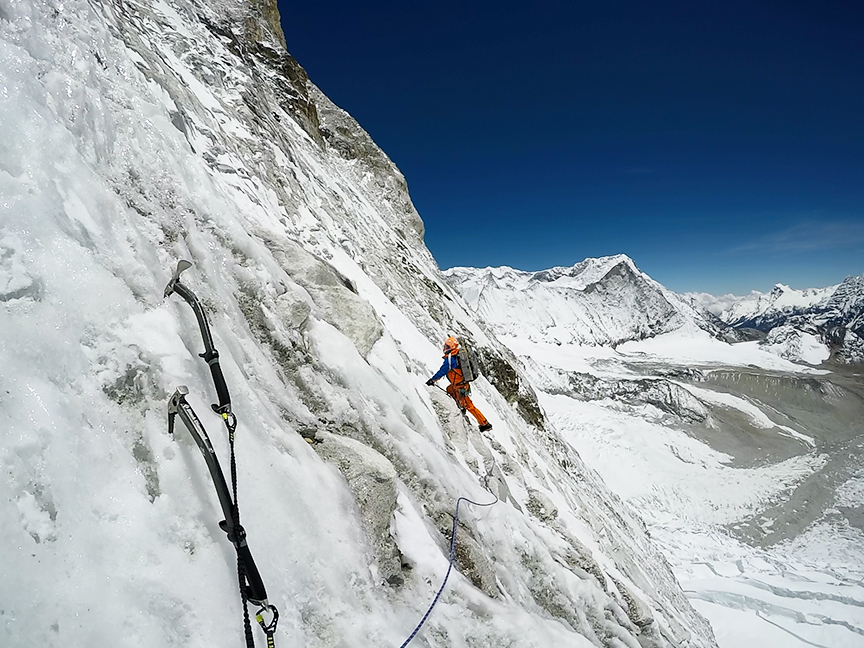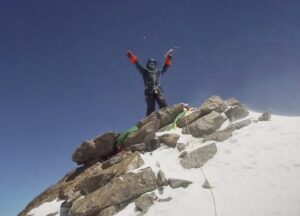Marek Holecek has gained a front-row seat in the hall of fame of the world’s high-altitude climbing elite. He is a regular on all lists of top-10 alpinists and on ExWeb’s own Best of the Year mentions. He has earned two Piolets d’Or and could be about to bag his third.
But as for 8,000m peaks, he has summited precisely one: Gasherbrum I. But he did it on the previously unclimbed SW Face, in pure alpine style. What he did and endured on that mountain alone is enough to fill several pages in books of mountaineering history. The constant search for excellence, the suffering, the drama, and the final triumph on a route that he simply called Satisfaction (ED+, M7, WI 5+).
It took him five attempts. He lost partner Zdenek Hruby, who died in a fall during their 2012 try. He endured avalanches, frostbite, and epic descents — a norm on his expeditions. And his first Piolet d’Or went to his eventual 2017 success on G1 with Zdenek Hak.

Marek Holcecek (right) and Zdenek Hak on the summit of Gasherbrum I.
The pair then reprised their formidable partnership in 2018 on the 2,000m-long UFO Life on the NW Face of Chamlang (7,321m). That one brought home a second Piolet d’Or.
While Everest and the other 8,000’ers usually cop most of the public attention in mountaineering, last year Marek Holecek’s escapades gave the Big E a run for its money. Holecek and partner Radoslav Groh fought their way up a new, highly exposed route on Baruntse‘s West Face. Their descent was, if possible, even more epic, as they desperately tried to escape a mountain hit by Cyclone Yaas. Their achievement brought back the sense of extreme adventure that the 8,000’ers have all but lost because of crowding and dependence on logistics.

Into Baruntse’s ‘Heavenly Trap’.
Those who look at Holecek’s resumé discover a climbing career with basically no ascent up any normal route. Instead, a stubborn fixation for the most difficult challenges a climber can face.
But does the interest in Holecek denote a changing of the mountain winds? Are new generations becoming more interested in high-commitment climbs than records? Or was the wide public interest simply because of the melodrama of their days trapped in the storm, unable to descend?
We asked Marek Holecek about this, among other things. This is what he had to say.
I do not think that the wider climbing community or the public is changing. The 14×8,000’ers as performed by Nirmal Purja, or the Nepali winter ascent of K2, still attracts the media like a magnet. And it is the media who form the views of most readers. To illustrate: In February 2022, National Geographic magazine published an article on the winter ascent of K2 under the headline ‘A Climb for History. Also, the major documentary Beyond Possible is running on Netflix, where Nirmal presents his ascents. According to the great interest, the media and the public obviously do not care where these stories stand in the real history of climbing, whether they respect the code and correspond to development. In my view, big words, but empty content.

Marek Holecek on Baruntse’s West Face in spring 2021.
Yet Holecek puts this in perspective, by pointing to great contemporary achievements happening at the same time.
The question is whether this [empty content] harms or hinders the development of alpinism. The answer is, it does not. This is proved by the great first ascents of last season: the Ukrainians on Annapurna III, the French on Chamlang, the Georgians on Saraghrar, the British on Tengkangpoche, and the Slovenians of Chobutse. Each of these performances showed an order of magnitude more imagination, skill, and beauty of execution. Mountaineering is not a competitive sport with winners and losers. This means that everyone can view beauty in their own way. It is closer to art.
All the ascents I have mentioned are the absolute best of the last season. At the same time, I do not forget about the ascents made in Kyrgyzstan, Alaska, Peru, Patagonia, and the Alps.
Of these highlighted climbs, Holecek is particularly familiar with one of them. “I attempted to climb the Annapurna III Pillar in 2003, but the weather did not allow us to even start the climb and we went home,” he explained. Holecek is good friends with the Ukrainian team members who opened the route.

Ukrainians Nikita Balavanov and Mikhail Fomin opened a new route on Annapurna III. From left to right: Balavanov, Fomin, and Marek Holecek.
It seems that fewer teams are aiming for new routes on the 8,000ers. Asked why, Holecek pointed to the “ever-increasing financial demands and the large number of people coming to the big hills,” as one of the main reasons.
“Climbers who have better skills and don’t want to use the fixed ropes installed by the Sherpas will redirect their aim to the lower hills, where they will enjoy climbing in a quiet mountain environment.”
Strategy for small expeditions dreaming big
Interestingly, some climbers have mentioned to ExplorersWeb that they feel Nepal outfitters, or the country’s authorities, are not making things easy for small, self-sufficient climbers aiming for less popular peaks. They suggest that Nepal is focused on attracting clients for commercial expeditions and not as interested in less profitable teams wanting to climb new routes on 6,000’ers and 7,000’ers. But that’s not a problem for Holecek, who has a strategy for those looking to climb the “lower hills.”
Where there is a will there is a way. We economize where we can. We acclimatize during the trek, which we intentionally make longer. This trek also includes a higher peak which we share with other trekkers. The lodge closest to the start of the ascent also serves as our base camp.
Our ascent of Chamlang is a good example. We set out on a trek from Lukla to Namche Bazaar, Chukhung, and the Amphu Labtsa Pass. After the 12-day trek, we continued acclimatization with an ascent of Mera Peak at 6,400m. We shared a permit that we bought together with a group of trekkers whom we met on the spot. Then we descended under Mera La to Kongmo Dingma, where lodges served as our base camp.
Our liaison officer (LO) came from the other side, from Lukla, accompanied by one porter who brought the rest of the climbing equipment and food for the ascent. We brought the gear to the mountain face and came back. Then we waited for satellite information about the weather. As soon as it looked good, we set out a day in advance and the next day we reached [our starting point].
After our descent, the porter took our equipment from Kongmo Dingma to Lukla and the LO left us. You will save [a lot of money without] the army of porters, a kitchen, and a cook. In this way, you can run around a lot of hills.
You can also share the cost of base camp and a permit with another expedition. Or, you can buy an expedition permit for one of the trekking hills and use the same lodge scheme.
You don’t have to spend money on services which you can do without.

Solitude and pure adventure. Opening the UFO life on Chamlang.
Holecek also avoids helicopters.
“The frequency of flights between Lukla and Everest on a nice day is hell,” he says. “There are about 10 a day, and flights are accompanied by constant noise which stops only with the arrival of dense clouds or bad weather.
“The vast majority of these are flightseeing runs and equipment transport. Rescue flights make up only a small part of this aerial highway.”
Baruntse
Holecek and Groh never asked for rescue during the eight days that the storm trapped them on Baruntse.
In the Himalaya, aerial rescue is significantly different from the Alps where a person can be picked up by rescuers who are suspended on a rope below the helicopter. In the Himalaya, the helicopter lands only on proven [safe] places. Not surprisingly, the high altitude limits the space to maneuvering, and the mountain area itself is huge.
When you embark on a project such as the face of Baruntse, you know very well that the chances of rescue by helicopter are not realistic. So you do not count on being rescued, nor do you ask for it.

Their new route on Baruntse, Heavenly Trap, is considered among the best climbs of 2021. Once again, Holecek and Groh are candidates for a Piolet d’Or. But the award is not a big deal for Holecek.
“I have never climbed to gain awards,” he told ExplorersWeb. “My motivation is fundamentally different. As for the Piolet d’Or, I consider it recognition for a quality ascent in which I built on the skills of my predecessors, following their code of ethics. There is no financial or material benefit, but that is fine.”
Baruntse also left some scars. Holecek suffered frostbitten fingers and toes.
“Everything is fine now, so I can reconsider going to the Karakoram in the autumn, following a dream that has matured over many years,” Holecek said.
What is next?
For those following Holecek’s career, the first image that comes to mind at the mention of a “long-time dream” in the Karakoram is Masherbrum. Masherbrum’s northeast face remains one of the greatest unsolved problems in high-altitude climbing.
“Yes, the giant Masherbrum is a possibility,” Holecek said. “We will see if there is enough snow on the face. Otherwise, we will have to go for a backup plan. We’ll decide this at the time.”
Holecek is coy regarding his plans beyond Masherbrum.
“I have not stopped believing that the best is still ahead of me, even if age goes against this vision,” said the 48-year-old.






